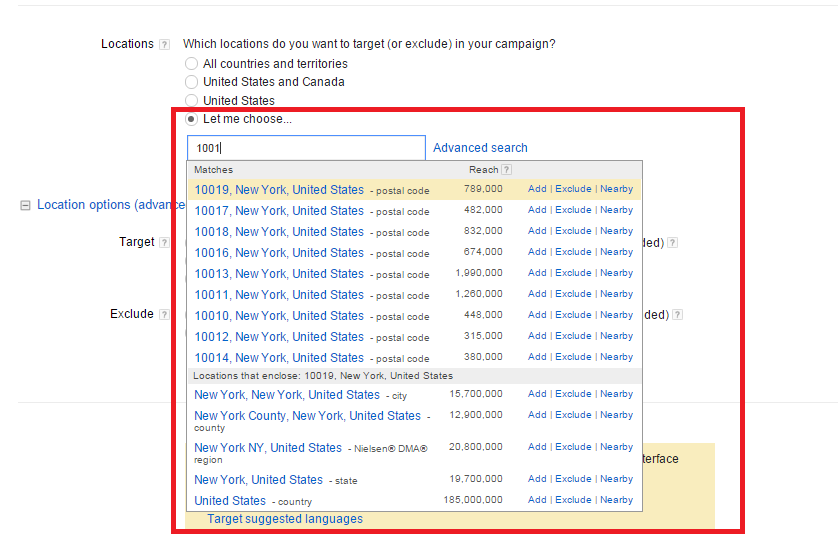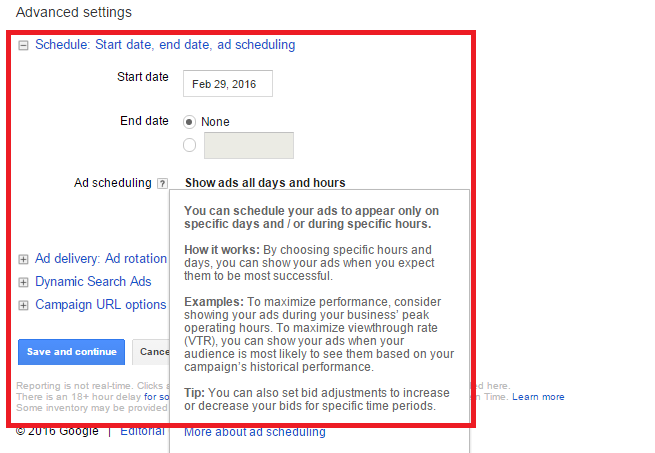
February 29, 2016: Google’s big decision to abandon the right rail ad sidebar (Right Rail-A-Geddon?) will make it tougher — and more expensive — for ads to appear in top-ranked positions accounting for the bulk of paid search clicks.
85 percent of clicks have historically come from top-of-organic ads, according to Wordstream. A reduction in available ad slot inventory will increase CPCs per the laws of supply and demand. So taking steps to reduce (or at least moderate) the costs of winning the auction required to gain a spot in the top-of-organic four pack is a task incumbent on every pay-per-click advertiser.
Fortunately, there are two effective weapons that will make your ads more likely to appear in this choice position: geo- and daypart-segmentation
Geographical segmentation

Location targeting in Google Adwords
It’s likely that your conversion rates measurably vary by geographical region. If you can isolate those areas most likely to yield a conversion for your ad, the money you save from not running ads in low-converting regions can be diverted to increasing your maximum bid in areas that convert better.
Google provides very precise location targeting that lets you draw areas around your business location (if you have a physical location) providing incremental bid-boosting based on a searcher’s distance from it.
Google lets you target different kinds of locations, including postal codes, cities, regions, and more. You can even target by DMAs (Designated Market Areas), so if you happen to know that people in these areas have a high (or low) propensity to consume your goods or services, you can double down on your bid price to get exposure (conversely, you can exclude low-converting DMAs to reduce waste).
Dayparting

Ad schedulling (Dayparting) in Google Adwords
It’s long been known that time of day is an indicator of likely conversion rate for many different businesses. For example, dating site subscription queries peak at certain hours during certain days of the week. B2B inquiries are low on weekends, when people are home and aren’t thinking about the workweek.
Take a look at when conversions are best (and worst) using Adwords’ Dimensions tab. Schedule ads with higher max bids that only show during top-converting time periods. You may find that you can afford to break into the top-of-organic four-pack, stealing clicks from your competitors at lower prices then they’re paying for unsegmented campaigns.
Combine Geo and Day-parting
Now take the final step: use both Geo-targeting and Dayparting together. Determine the time-of-day conversion variances for each one of your choice DMAs, and bid more aggressively for them. Now you’re on the road to showing ads just to your best likely customers and prospects.
Not every marketer can use this level of sophistication to design and run truly efficient campaigns. The effectiveness of this kind of targeting is generally proportional to the amount of data – and its quality — that one has on hand. 3rd party bid management systems are very useful in terms of programming all the various targeting levers that need to be set. Sometimes it’s most efficient to have a specialist agency handle these chores.
But there’s no question that being able to use more these segmentation levers will make your campaigns more competitive — and better able to get your ads shown — at affordable cost — than campaigns lacking this ability.
Don’t be demoralized by “Right-Rail-A-Geddon.” Go forth and segment!
- 10 Mistakes to Avoid When Using QR Codes for Marketing - September 20, 2023
- Kevin Lee on How AI Changes the SEO Landscape - August 31, 2023
- The Power of Compound Marketing: Kevin Lee Presents @ 1MediaWorld 2023 Global Conference - March 7, 2023

